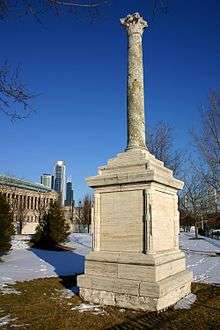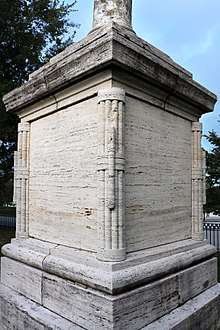Balbo Monument
The Balbo Monument consists of a column that is approximately 2,000 years old dating from between 117 and 38 BC and a contemporary stone base. It was taken from an ancient port town outside of Rome by Benito Mussolini and gifted to the city of Chicago in 1933 to honor the trans-Atlantic flight led by Italo Balbo to the Century of Progress Worlds Fair.[1]

History
The Balbo Monument includes a column that was taken from a site about 200 meters outside of Porta Marina in Ostia. The building that the column originated from is called the Prospetto a Mare which translates to the Prospectus to Sea.[2] Due to extensive renovation that was done during the second century AD, many of the buildings throughout the settlement of Ostia were repurposed or built over.[3] Although this building endured through years of change and innovation, there are very few records still in existence that pertain to the building's original purpose.
Creation

The Romans constructed the column from breccia,[1] a type of stone created from the combination of angular gravel and the fragments of boulders.[4] The pillar is a greenish color, thirteen feet tall and three feet in diameter.[5] Two Italian architects named Capraro and Komar created the base of the monument[1] out of travertine,[2] a type of light colored limestone frequently used in Roman architecture.[6] They inscribed a message in Italian. In English the message reads:
This column
twenty centuries old
erected on the beach of Ostia
port of Imperial Rome
to safeguard the fortunes and victories
of the Roman triremes
Fascist Italy, by command of Benito Mussolini,
presents to Chicago
exaltation, symbol, memorial
of the Atlantic Squadron led by Balbo
that with Roman daring flew across the ocean
in the 11th year
of the Fascist era.[2]
Controversy
The monument represents a portion of history but it is also valued as a piece of art and it stands as a symbol that has very different meanings for different groups of people.[2] Italo Balbo was part of the Fascist Italian government that colonised Libya and Ethiopia, and led an air force which employed the use of chemical weapons that resulted in the death of thousands of civilians.
After Benito Mussolini had the pillar removed from its original place in Ostia, he had it converted into a monument that he gifted to the City of Chicago. It was transported by boat to America and arrived in Chicago in 1934 during the Century of Progress World's fair and placed in front of the Italian Pavilion. While the fair was eventually disassembled, the column was left standing in its original place just a short distance from the shores of Lake Michigan in an often overlooked area of Burnham Park.[2] This token was a tribute to the first transatlantic crossing made by the Italian air force and their general, Italo Balbo.[2]
At the time of this celebration, relations between Fascist Italy and the United States were friendly [7][8]. In fact, they had been for most of the duration of the regime. Mussolini, Grandi, Balbo and others were recurringly portrayed in a positive light on American media, with Mussolini featured on Newsweek as late as May 1940. Balbo in particular was hugely popular, especially in Chicago [9] and New York [10].
After the end of Second World War, the anti-fascist Italian ambassador to the United States Alberto Tarchiani requested for the tributes to Balbo to be removed. The mayor, surprised, reportedly asked: "Why? Didn't Balbo cross the Atlantic?" [11].
In 2017 there has been discussion about removing the monument [12], which as of April 2018 seems likely to remain [13].
As is evident from its current existence, Balbo's pillar endured in spite of intermittent objections.[14] There are still mixed emotions that survive to this day. Some believe the monument to be a controversial link to Fascism while older Chicago residents hold on to fond memories of an age of progress.[1]
In post-fascist Italy, most monuments and streets named after Balbo during the Fascist Regime reverted to their pre-Fascist names, such as in Palermo, liberated by the Allies in July 1943, where Piazza Italo Balbo reverted to its former name, Piazza Bologni, or were named after anti-fascist partisans, such as in San Remo, where "Via Italo Balbo" was renamed after partisan Luigi Nuvoloni. [15]
See also
Further reading
| Wikimedia Commons has media related to Balbo Monument. |
- Segrè, Claudio G. 1987. Italo Balbo: a Fascist life. Berkeley: University of California Press.
- Bosworth, R. J. B. 2002. Mussolini. London: Arnold.
- Ganz, Cheryl. 2008. The 1933 Chicago World's Fair: a century of progress. Urbana: University of Illinois Press.
- Aldrete, Gregory S. 2004. Daily life in the Roman city: Rome, Pompeii, and Ostia. Westport, Conn: Greenwood Press.
References
- "Balbo Monument". Chicago Park District. Chicago Park District. Archived from the original on 28 March 2016. Retrieved 21 February 2016.
- "A Column from Ostia in Chicago". Ostia Harbour City of Ancient Rome. Retrieved 21 February 2016.
- "Ostia Introduction". Ostia Harbour City of Ancient Rome. Retrieved 21 February 2016.
- "Breccia". Geology Rocks and Minerals. Auckland University. Retrieved 21 February 2016.
- "Mussolini to Give Chicago an Ancient Roman Column". Chicago Tribune. Chicago Tribune. Retrieved 21 February 2016.
- "Travertine". Encyclopædia Britannica. Encyclopædia Britannica. Retrieved 21 February 2016.
- Diggins, John Patrick (2015). Mussolini and Fascism: The View from America. Princeton University Press. ISBN 9780691617886.
- Migone, Gian Giacomo (2015). The United States and Fascist Italy: The Rise of American Finance in Europe. Cambridge University Press. ISBN 9781107002456.
- "Chicago Fetes Balbo". Chicago Tribune. 17 July 1933.
- "Great Italian armada is acclaimed by millions as it wings over the city". New York Times. 20 July 1933.
- Segre, Claudio (1990). Italo Balbo: a Fascist life. University of California Press. p. 264. ISBN 978-0520071995.
- LaTrace, AJ (15 August 2017). "Is it time to remove the Balbo monument from Grant Park?". Retrieved 1 February 2019.
- "Monument to fascist Balbo likely to remain, but aldermen could still rename street". 23 April 2018. Retrieved 1 February 2019.
- Wrigley, Amanda. "From Ancient Rome to Chicago: Mussolini's Gift of the Balbo Column" (PDF). Northwestern. Retrieved 21 February 2016.
- Carter, Nick (31 May 2018), "The meaning of monuments: remembering Italo Balbo in Italy and the United States", Cambridge University Press, retrieved 22 January 2019